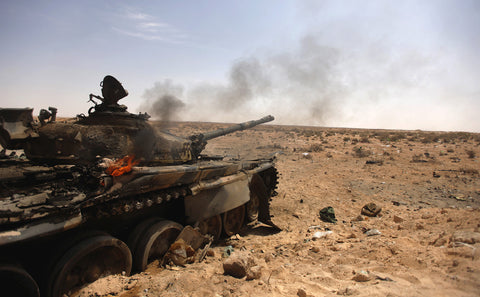
Are Tanks Obsolete?
Throughout the history of human warfare the backbone of any army has been the common soldier, who has had to endure terrifying inventions—from the chariot to the mounted cavalryman to the motorized armored fighting vehicle—an enemy develops to gain an edge over him. Against every such juggernaut, however, the infantryman hasn’t been entirely helpless—not as long as his own mad scientists have applied their ingenuity to develop countermeasures and increase his odds of survival.
On Sept. 15, 1916, Britain introduced its Mark I tank at the Battle of Flers- Courcelette, amid the Somme campaign, with modest success. It wasn’t long before the Germans tried to counter it with the steel-cored K ( Kern , or “core”) bullet, a 7.92×57 mm round able to pierce tank armor when fired from a standard Mauser Gewehr 98 rifle. In 1918, as the Allies rolled out tanks with thicker armor, Mauser introduced the specialized T- Gewehr rifle, firing a 13.2 ×92 mm TuF ( Tank und Flieger , or “tank and plane”) round. Thereafter, the arms race was on, as opponents rushed to counter newer, deadlier armored vehicles with more sophisticated “equalizers” intended to give the infantryman a chance of holding his ground. Tanks have since acquired their share of enhanced protection. But aided by such pivotal creations as rocket propulsion, the shaped charge and computerized guidance systems, the current species of “ground pounder” carries his own means to pound back.
British Mark IV tanks spearhead a British advance
through a barrage of German artillery in 1917.
Judging its 7.92×57 mm K round
inadequate, Mauser was inspired by elephant guns to develop the first
specialized antitank rifle, the 13.2×92 mm T-Gewehr. The gun entered
production in May 1918, and Mauser made 16,900 by war’s end.
A Soviet soldier fires a PTRS-41 semiautomatic
antitank rifle in early 1944, by which time its primary use was against brick
and other hardened strongpoints, not armor. That said, it could penetrate
armor plate up to 40 mm thick at 100 meters.
Hungarian 38M Toldi light tanks advance into the
Soviet Union in the fall of 1941. Thinly armored and armed with 20 mm
Solothurn cannons, these were typical fodder for Russian antitank rifles.
The
Panzerfaust had limited range and accuracy, but proved well suited for defense
in urban environments.
German troops meet
oncoming Soviet forces with a Panzerschreck, a larger, more powerful version
of the American bazooka antitank rocket launcher, near Narva in August 1944.
Caught by counterattacking U.S. tanks (in the
background), a North Korean T-34/85 brews up north of Yongsan on Sept. 9,
1950. Korea’s terrain made tank-versus-tank duels a rarity.
U.S. Army troops train on the
M20 on July 18, 1950. Introduced early that year, the M20 had a shaped charge
that could penetrate 11 inches of armor and was a dramatic improvement over
the 2.36-inch bazooka of World War II.
An
M48A3 Patton advances through a Vietnamese forest, its crew vigilant for
possible Viet Cong ambush, which may well involve a rocket-propelled grenade
(RPG), the tank’s principal nemesis.
In a communist propaganda photo set during
the January 1968 Tet Offensive, a female Viet Cong spearheads an assault in
the Mekong Delta using an RPG-7.
A Syrian rebel fires a BGM-71 TOW (tube-
launched, optically tracked, wire-guided) antitank missile at Hafez al-Assad’s
government forces in northern Aleppo on July 17, 2016. Entering service in
1970, the American TOW remains a staple in worldwide conflicts.
Disabled by an antitank missile, a Syrian government
T-72 tank lies abandoned in al-Khalidiyah, near Homs, on July 28, 2013.
Disabled Russian tanks go on display like trophies in
Mariupol on May 4, 2022. The reactive armor applied over the hull and turret
plating was not enough to fend off Ukrainian missiles
A Ukrainian soldier practices on an NLAW (next
generation light antitank weapon) on Jan. 28, 2022—less than a month before
Ukrainians would be forced to put that training into practice.
Struck by a Ukrainian antitank weapon on Feb. 26,
2022, a T-90, the first tank produced by Russia since the Cold War, burns on
the road from Luhansk to Kyiv—an inauspicious start for Vladimir Putin’s
“special military operation.”
